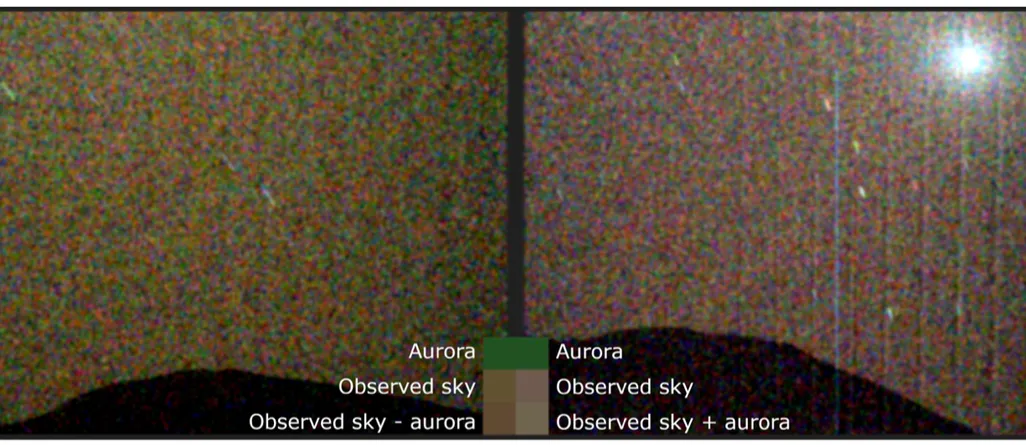See the First Visible Auroras Captured on Mars, Glowing a Hazy Green Above the Planet
See the First Visible Auroras Captured on Mars, Glowing a Hazy Green Above the Planet
Scientists directed NASA’s Perseverance rover to take an image of the Martian sky after a solar storm in hopes that an aurora would show up
Lillian Ali
- Staff Contributor
May 16, 2025 1:19 p.m.
The first image in visible light of green auroras on Mars, compared to the night sky of Mars without auroras.
NASA / JPL-Caltech / ASU / MSSS / SSI
On March 18, 2024, NASA’s Perseverance rover, which usually examines rocks on Mars’ surface, tilted its camera upward. The planet’s entire sky glowed a soft green, and the rover snapped an image of the moment—capturing the first visually observed aurora on Mars.
The photograph is the result of several years of planning, waiting and retrying to grab this shot. Researchers led by Elise Wright Knutsen, an atmospheric physicist at the University of Oslo, waited for the right conditions and commanded Perseverance to look up at exactly the right time. They reported their feat in a study published Wednesday in the journal Science Advances.
“It took three unsuccessful attempts before we got it right, but when we did, it appeared exactly as we imagined it; as a diffuse green haze, uniform in all directions,” Knutsen tells Gizmodo’s Passant Rabie.Auroras can occur following a solar storm, when the sun suddenly blasts charged particles, energy and magnetic fields into the solar system. These particles can collide with gases in a planet’s atmosphere, energizing them and causing their atoms to emit light in different colors.
On Earth, the charged particles from the sun are guided to the poles by the magnetic field, leading to the northern and southern lights. Mars does not have a global magnetic field, “so the charged particles bombarded all of Mars at the same time, which leads to this planet-wide aurora,” Knutsen tells Reuters’ Will Dunham.
The Martian atmosphere is much thinner than Earth’s, and it doesn’t have as many gas atoms that could light up in an aurora. But Mars has atomic oxygen, and oxygen on Earth causes a green glow. So, astronomers thought its sky would appear green after a solar storm, although the hue would be fainter and harder to capture than auroras on Earth. Historically, Mars’ auroras have only been observed by orbiting spacecraft in ultraviolet light, which is not visible to the naked eye.
An aurora seen from Abisko, Sweden, glows green due to emissions from atmospheric oxygen.
Pavel.shyshkouski via Wikimedia Commons under CC BY-SA 4.0
Perseverance’s photo surprised some scientists, who had anticipated an image of an aurora to come from a spacecraft instead. “I didn’t really expect it to be seen by one of the rovers,” planetary astronomer James O’Donoghue of the University of Reading in England, who was not involved in the study, tells the New York Times’
Perseverance’s mission is to sample rocks that may contain evidence of ancient microbial life, like “Cheyava Falls,” a rock discovered last year that scientists say bears a potential biosignature. To observe an aurora, researchers applied the rover’s rock-studying instruments to the sky. One of its cameras, Mastcam-Z, could spot green lights. An instrument called SuperCam would chemically analyze whatever was emitting that green light, potentially identifying an aurora.
To get their photo, researchers had to accurately forecast the aurora by observing the sun, studying the Martian atmosphere and perfectly timing Perseverance’s movements. After several months, during a period of solar hyperactivity, Knutsen’s team found exactly the right moment.
“It was so satisfying,” Knutsen tells the New York Times.
NASA's Perseverance rover took this "selfie" on July 23, 2024, with a rock nicknamed "Cheyava Falls."
NASA / JPL-Caltech / MSSS
Perseverance’s instruments determined the aurora emitted light with a wavelength of 557.7 nanometers—a green glow that’s visible to the human eye—which told astronomers the source was oxygen. Data from NASA’s orbiting MAVEN mission confirmed the light came from an aurora caused by solar energetic particles.
Capturing an aurora on Mars opens new methods of studying the planet’s atmosphere and weather. It also shows how scientists can continue to track solar activity, which is especially relevant as a solar flare caused radio blackouts internationally this week.
For now, though, Knutsen’s team gets to celebrate capturing the first visible Martian aurora. She tells the New York Times about being one of the first people to see “a black horizon and a softly glowing green sky” on Mars, saying, “I cried a little bit.”
Get the latest stories in your inbox every weekday.
#see #first #visible #auroras #captured
See the First Visible Auroras Captured on Mars, Glowing a Hazy Green Above the Planet
See the First Visible Auroras Captured on Mars, Glowing a Hazy Green Above the Planet
Scientists directed NASA’s Perseverance rover to take an image of the Martian sky after a solar storm in hopes that an aurora would show up
Lillian Ali
- Staff Contributor
May 16, 2025 1:19 p.m.
The first image in visible light of green auroras on Mars, compared to the night sky of Mars without auroras.
NASA / JPL-Caltech / ASU / MSSS / SSI
On March 18, 2024, NASA’s Perseverance rover, which usually examines rocks on Mars’ surface, tilted its camera upward. The planet’s entire sky glowed a soft green, and the rover snapped an image of the moment—capturing the first visually observed aurora on Mars.
The photograph is the result of several years of planning, waiting and retrying to grab this shot. Researchers led by Elise Wright Knutsen, an atmospheric physicist at the University of Oslo, waited for the right conditions and commanded Perseverance to look up at exactly the right time. They reported their feat in a study published Wednesday in the journal Science Advances.
“It took three unsuccessful attempts before we got it right, but when we did, it appeared exactly as we imagined it; as a diffuse green haze, uniform in all directions,” Knutsen tells Gizmodo’s Passant Rabie.Auroras can occur following a solar storm, when the sun suddenly blasts charged particles, energy and magnetic fields into the solar system. These particles can collide with gases in a planet’s atmosphere, energizing them and causing their atoms to emit light in different colors.
On Earth, the charged particles from the sun are guided to the poles by the magnetic field, leading to the northern and southern lights. Mars does not have a global magnetic field, “so the charged particles bombarded all of Mars at the same time, which leads to this planet-wide aurora,” Knutsen tells Reuters’ Will Dunham.
The Martian atmosphere is much thinner than Earth’s, and it doesn’t have as many gas atoms that could light up in an aurora. But Mars has atomic oxygen, and oxygen on Earth causes a green glow. So, astronomers thought its sky would appear green after a solar storm, although the hue would be fainter and harder to capture than auroras on Earth. Historically, Mars’ auroras have only been observed by orbiting spacecraft in ultraviolet light, which is not visible to the naked eye.
An aurora seen from Abisko, Sweden, glows green due to emissions from atmospheric oxygen.
Pavel.shyshkouski via Wikimedia Commons under CC BY-SA 4.0
Perseverance’s photo surprised some scientists, who had anticipated an image of an aurora to come from a spacecraft instead. “I didn’t really expect it to be seen by one of the rovers,” planetary astronomer James O’Donoghue of the University of Reading in England, who was not involved in the study, tells the New York Times’
Perseverance’s mission is to sample rocks that may contain evidence of ancient microbial life, like “Cheyava Falls,” a rock discovered last year that scientists say bears a potential biosignature. To observe an aurora, researchers applied the rover’s rock-studying instruments to the sky. One of its cameras, Mastcam-Z, could spot green lights. An instrument called SuperCam would chemically analyze whatever was emitting that green light, potentially identifying an aurora.
To get their photo, researchers had to accurately forecast the aurora by observing the sun, studying the Martian atmosphere and perfectly timing Perseverance’s movements. After several months, during a period of solar hyperactivity, Knutsen’s team found exactly the right moment.
“It was so satisfying,” Knutsen tells the New York Times.
NASA's Perseverance rover took this "selfie" on July 23, 2024, with a rock nicknamed "Cheyava Falls."
NASA / JPL-Caltech / MSSS
Perseverance’s instruments determined the aurora emitted light with a wavelength of 557.7 nanometers—a green glow that’s visible to the human eye—which told astronomers the source was oxygen. Data from NASA’s orbiting MAVEN mission confirmed the light came from an aurora caused by solar energetic particles.
Capturing an aurora on Mars opens new methods of studying the planet’s atmosphere and weather. It also shows how scientists can continue to track solar activity, which is especially relevant as a solar flare caused radio blackouts internationally this week.
For now, though, Knutsen’s team gets to celebrate capturing the first visible Martian aurora. She tells the New York Times about being one of the first people to see “a black horizon and a softly glowing green sky” on Mars, saying, “I cried a little bit.”
Get the latest stories in your inbox every weekday.
#see #first #visible #auroras #captured
·143 Visualizações


